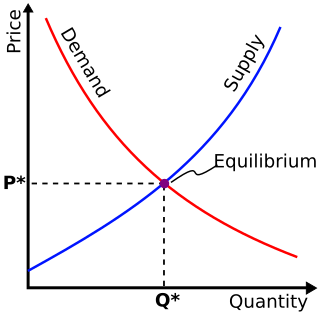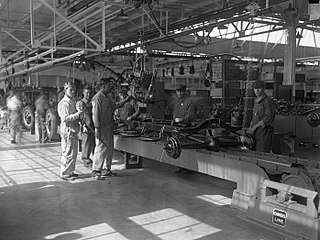Further reading
- Work Systems: The Methods, Measurement & Management of Work by Mikell P. Groover, Prentice-Hall (2006) ISBN 0-13-140650-7
- Work Measurement and Methods Improvement by Lawrence S. Aft, Wiley (2000) ISBN 0-471-37089-4
Standard time is the amount of time that should be allowed for an average worker to process one work unit using the standard method and working at a normal pace. The standard time includes some additional time, called the contingency allowance, to provide for the worker's personal needs, fatigue, and unavoidable delays during the shift.
The standard time (Ts) is calculated from multiplying the observed time (To) by the performance rating (R) and the personal need, fatigue and unavoidable delays (PFD): Ts = To*R*(1+PFD)
Industrial and organizational psychology "focuses the lens of psychological science on a key aspect of human life, namely, their work lives. In general, the goals of I-O psychology are to better understand and optimize the effectiveness, health, and well-being of both individuals and organizations." It is an applied discipline within psychology and is an international profession. I-O psychology is also known as occupational psychology in the United Kingdom, organisational psychology in Australia and New Zealand, and work and organizational (WO) psychology throughout Europe and Brazil. Industrial, work, and organizational (IWO) psychology is the broader, more global term for the science and profession.
In electronics and telecommunications, jitter is the deviation from true periodicity of a presumably periodic signal, often in relation to a reference clock signal. In clock recovery applications it is called timing jitter. Jitter is a significant, and usually undesired, factor in the design of almost all communications links.
Therbligs are elemental motions used in the study of workplace motion economy. A workplace task is analyzed by recording each of the therblig units for a process, with the results used for optimization of manual labour by eliminating unneeded movements. Eighteen therbligs have been defined.

Productivity is the efficiency of production of goods or services expressed by some measure. Measurements of productivity are often expressed as a ratio of an aggregate output to a single input or an aggregate input used in a production process, i.e. output per unit of input, typically over a specific period of time. The most common example is the (aggregate) labour productivity measure, one example of which is GDP per worker. There are many different definitions of productivity and the choice among them depends on the purpose of the productivity measurement and data availability. The key source of difference between various productivity measures is also usually related to how the outputs and the inputs are aggregated to obtain such a ratio-type measure of productivity.
GOMS is a specialized human information processor model for human-computer interaction observation that describes a user's cognitive structure on four components. In the book The Psychology of Human Computer Interaction. written in 1983 by Stuart K. Card, Thomas P. Moran and Allen Newell, the authors introduce: "a set of Goals, a set of Operators, a set of Methods for achieving the goals, and a set of Selections rules for choosing among competing methods for goals." GOMS is a widely used method by usability specialists for computer system designers because it produces quantitative and qualitative predictions of how people will use a proposed system.
Methods engineering is a subspecialty of industrial engineering and manufacturing engineering concerned with human integration in industrial production processes.

A time and motion study is a business efficiency technique combining the Time Study work of Frederick Winslow Taylor with the Motion Study work of Frank and Lillian Gilbreth. It is a major part of scientific management (Taylorism). After its first introduction, time study developed in the direction of establishing standard times, while motion study evolved into a technique for improving work methods. The two techniques became integrated and refined into a widely accepted method applicable to the improvement and upgrading of work systems. This integrated approach to work system improvement is known as methods engineering and it is applied today to industrial as well as service organizations, including banks, schools and hospitals.
Reliability engineering is a sub-discipline of systems engineering that emphasizes the ability of equipment to function without failure. Reliability is defined as the probability that a product, system, or service will perform its intended function adequately for a specified period of time, OR will operate in a defined environment without failure. Reliability is closely related to availability, which is typically described as the ability of a component or system to function at a specified moment or interval of time.
A predetermined motion time system (PMTS) is frequently used to perform labor minute costing in order to set piece-rates, wage-rates or incentives in labor oriented industries by quantifying the amount of time required to perform specific tasks under defined conditions. Today the PMTS is mainly used in work measurement for shorter cycles in labour oriented industries such as apparel and footwear. This topic comes under wider industrial and production engineering. One of such a system is known as "work factor" and more popular methods-time measurement (MTM), released in 1948 exist today in several variations and used in some commercial applications.

Operations management is concerned with designing and controlling the production of goods and services, ensuring that businesses are efficient in using resources to meet customer requirements.

Piece work or piecework is any type of employment in which a worker is paid a fixed piece rate for each unit produced or action performed, regardless of time.
In industrial engineering, the standard time is the time required by an average skilled operator, working at a normal pace, to perform a specified task using a prescribed method. It includes appropriate allowances to allow the person to recover from fatigue and, where necessary, an additional allowance to cover contingent elements which may occur but have not been observed.
Methods-Time Measurement (MTM) is a predetermined motion time system that is used primarily in industrial settings to analyze the methods used to perform any manual operation or task and, as a product of that analysis, to set the standard time in which a worker should complete that task.
Control is a function of management that helps to check errors and take corrective actions. This is done to minimize deviation from standards and ensure that the stated goals of the organization are achieved in a desired manner.
Work measurement is the application of techniques which is designed to establish the time for an average worker to carry out a specified manufacturing task at a defined level of performance. It is concerned with the duration of time it takes to complete a work task assigned to a specific job. It means the time taken to complete one unit of work or operation it also that the work should completely complete in a complete basis under certain circumstances which take into account of accountants time
Work sampling is the statistical technique used for determining the proportion of time spent by workers in various defined categories of activity. It is as important as all other statistical techniques because it permits quick analysis, recognition, and enhancement of job responsibilities, tasks, performance competencies, and organizational work flows. Other names used for it are 'activity sampling', 'occurrence sampling', and 'ratio delay study'.
Performance rating is the step in the work measurement in which the analyst observes the worker's performance and records a value representing that performance relative to the analyst's concept of standard performance.
PFD allowance in work systems is the adjustment done to the normal time to obtain the standard time for the purpose of recovering the lost time due to personal needs, fatigue, and unavoidable delays. By providing a small increase to the normal time in each cycle, a worker can still be able to cover lost time and complete the work assigned to him or her.

Ergonomics, also known as human factors or human factors engineering (HFE), is the application of psychological and physiological principles to the engineering and design of products, processes, and systems. Primary goals of human factors engineering are to reduce human error, increase productivity and system availability, and enhance safety, health and comfort with a specific focus on the interaction between the human and equipment.
The following is a glossary of terms relating to construction cost estimating.